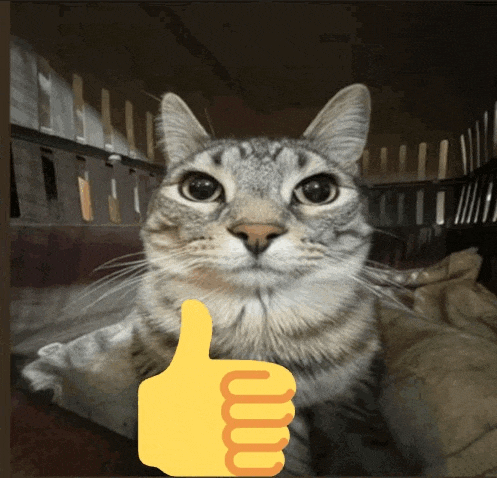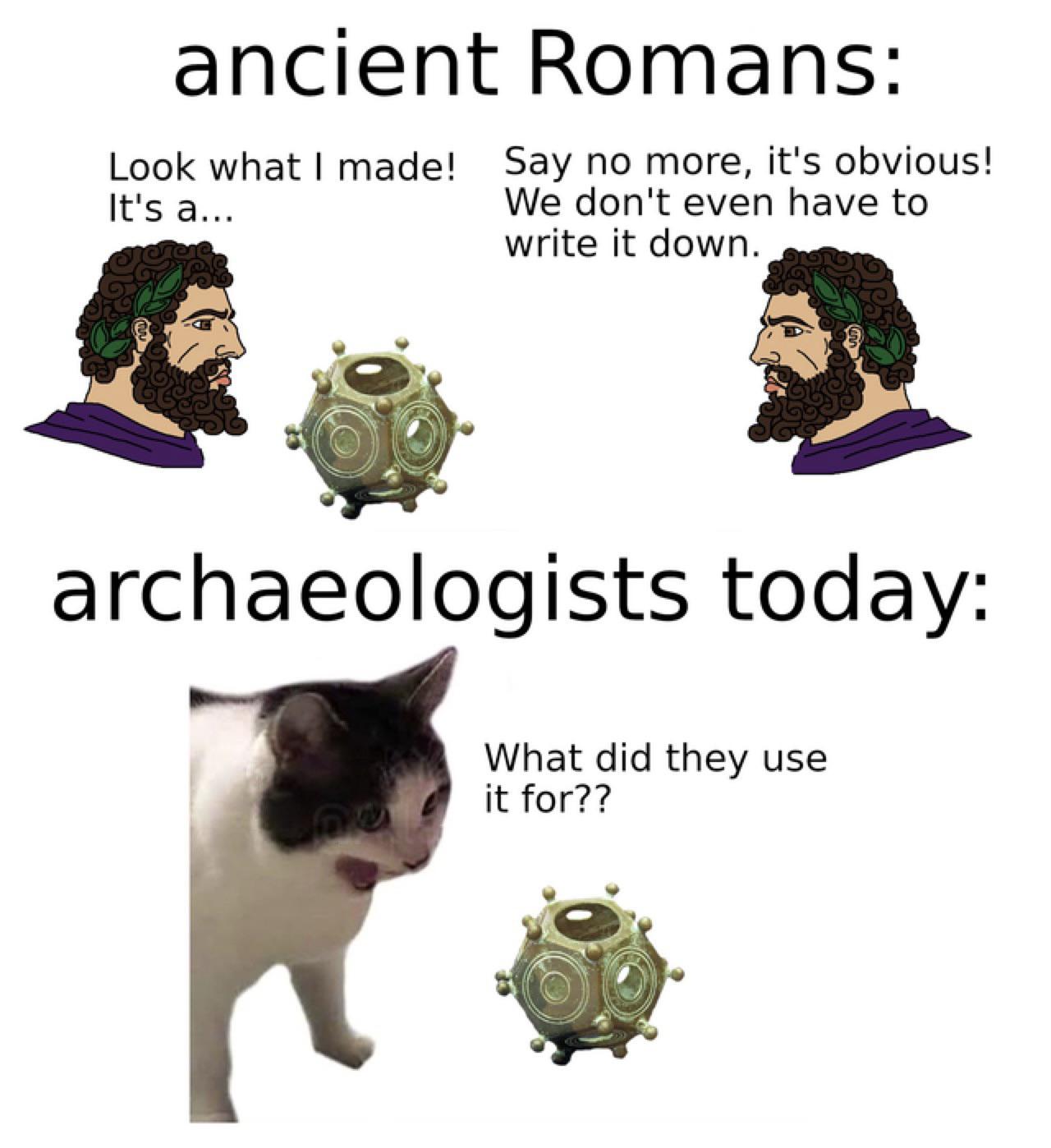"Everyone knows what a horse is"
-
It’s obviously a dick-measuring tool
-
Maybe oversized sweaters were a thing back then
Gotta keep the giants and dragons warm
-
So you’re saying I’m a ritual object? Huh, go figure.
-
Gotta keep the giants and dragons warm
God-sized sweaters and socks to offer at the sermons in temples
-
I can't remember if it's an official Asimov book or not, but one of the Foundation books set far beyond even the main series has an archaeological mission finding thousands of ceremonial hard white ceramic bowl-funnels and speculating on their significance to these incomprehensibly ancient peoples.
-
People back then loved their religious calendars. That's all they ever talked about. Whole books could be written about them.
But instead of books to write about them, they documented their love of religious calendar artifacts, with more calendar artifacts.
-
People say this every time, and it’s still not true, because the Romans didn’t knit. Knitting is a technology and it hadn’t made it to Rome at the time these were made.
Also, some were solid and unsuitable for knitting. And they were found with giant piles of money, which is a weird place to keep your domestic tools.
-
People say this every time, and it’s still not true, because the Romans didn’t knit. Knitting is a technology and it hadn’t made it to Rome at the time these were made.
Also, some were solid and unsuitable for knitting. And they were found with giant piles of money, which is a weird place to keep your domestic tools.
Knitting
-
Oh well if you put it that way I guess it’s knitting
-
I can't remember if it's an official Asimov book or not, but one of the Foundation books set far beyond even the main series has an archaeological mission finding thousands of ceremonial hard white ceramic bowl-funnels and speculating on their significance to these incomprehensibly ancient peoples.
thousands
There's probably millions even if you account for the fact that most would have been destroyed
-
What if instead toilet seats become a symbol for a group of genetically engineered super soldiers known for being Mary Sues?
-
Oh well if you put it that way I guess it’s knitting
Good

-
-
Here's my contribution to the 'what the fuck are these things' guesses:
Its a customizable, weighted D12.
You stick the coins into the slots, then do some kind of gambling involving dice rolls.
Part of the game is that as coins are added or removed, the weighting changes.
Hell, it could be that you take turns tossing the thing till its full of coins, as a way of anteing up, then just toss it again untill its empty, everyone takes a drink when it lands with a hollow slot face up.
The educated, literate people probably wouldn't bother to write down the exact details of a low class gambling game, when literacy is rare and scrolls/books are expensive.
The things have reportedly often been found in cabinets and drawers alongside coins.
They vary in size... maybe some of the rather large ones could be commissioned as not a practical gambling die, but as an exxageratedly large one, as a trophy or ornament, like modern mall ninja swords or funko pops or
Possibly they could also serve a practical purpose for normal people and coin minters to check that their coins are properly sized.
Any... Roman numismatists here that can sanity check this, in terms of coin sizes?
-
Looks like a bigass thundercube to me. Don't wanna fiddle with them too much, they might get krangled.
-
Here's my contribution to the 'what the fuck are these things' guesses:
Its a customizable, weighted D12.
You stick the coins into the slots, then do some kind of gambling involving dice rolls.
Part of the game is that as coins are added or removed, the weighting changes.
Hell, it could be that you take turns tossing the thing till its full of coins, as a way of anteing up, then just toss it again untill its empty, everyone takes a drink when it lands with a hollow slot face up.
The educated, literate people probably wouldn't bother to write down the exact details of a low class gambling game, when literacy is rare and scrolls/books are expensive.
The things have reportedly often been found in cabinets and drawers alongside coins.
They vary in size... maybe some of the rather large ones could be commissioned as not a practical gambling die, but as an exxageratedly large one, as a trophy or ornament, like modern mall ninja swords or funko pops or
Possibly they could also serve a practical purpose for normal people and coin minters to check that their coins are properly sized.
Any... Roman numismatists here that can sanity check this, in terms of coin sizes?
The educated, literate people probably wouldn’t bother to write down the exact details of a low class gambling game, when literacy is rare and scrolls/books are expensive.
Interesting enough, the Roman Emperor Claudius, who was an enthusiastic dicer, wrote a book on gaming/gambling. It's been lost to time, unfortunately.
Literacy is a funny question in regards to the Roman Empire, as is the price of scrolls/books. There's limited evidence that scrolls and books were actually cheaper in the Roman Empire than in the 15th century AD, just before and in-the-early-days-of moveable type, and that urban literacy was fairly widespread. The big problem is that the vast majority of ancient writing simply has not survived the ages.
I'm not well-informed about the dodecahedrons or the theories surrounding them, but I'm inclined to find your explanation, while interesting, probably a bit too complex. Especially considering that coins were often slightly irregular in shape, as the mass-produced neat, perfect circles that we're used to are a result of modern milled coinage
-
The educated, literate people probably wouldn’t bother to write down the exact details of a low class gambling game, when literacy is rare and scrolls/books are expensive.
Interesting enough, the Roman Emperor Claudius, who was an enthusiastic dicer, wrote a book on gaming/gambling. It's been lost to time, unfortunately.
Literacy is a funny question in regards to the Roman Empire, as is the price of scrolls/books. There's limited evidence that scrolls and books were actually cheaper in the Roman Empire than in the 15th century AD, just before and in-the-early-days-of moveable type, and that urban literacy was fairly widespread. The big problem is that the vast majority of ancient writing simply has not survived the ages.
I'm not well-informed about the dodecahedrons or the theories surrounding them, but I'm inclined to find your explanation, while interesting, probably a bit too complex. Especially considering that coins were often slightly irregular in shape, as the mass-produced neat, perfect circles that we're used to are a result of modern milled coinage
Ah well, worth a shot.
-
A NEW HAND TOUCHES THE BEACON
-
And they don't show signs of wear and tear that using them for such a purpose would create, either.

